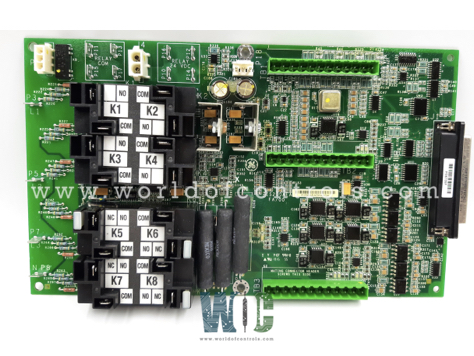SPECIFICATIONS
Part No.: IS200AEADH4ADA
Manufacturer: General Electric
Country of Manufacture: United States of America (USA)
Temperature rating: 30 to 65 oC
Size: 17.8 cm wide x 33.02 cm high
Number of relay channels: 12
Product Type: Input Terminal Board
Availability: In Stock
Series: Drive Control
Functional Description
IS200AEADH4ADA is an input terminal board developed by GE. It is a part of the drive control system. The system I/O interface is engineered for direct connection to the turbine's sensors and actuators, effectively bypassing the requirement for additional instrumentation. This design choice not only streamlines the setup process but also mitigates potential reliability and maintenance concerns typically associated with intermediary instrumentation.
System Features
- Ideal Placement of the Control System Cabinet: For optimal performance and longevity of the control system, it is recommended to install the cabinet in an environmentally controlled room or within the control room itself. When selecting the installation location, ensure that the floor surface provides a flat, level, and continuous surface for secure attachment. The customer is responsible for providing the necessary mounting hardware to affix the cabinet securely in place.
- Considerations for Lifting and Handling: The cabinet is equipped with lifting lugs to facilitate handling during installation. If lifting lugs are utilized, it's essential to ensure that the lifting cables do not exceed a 45 angle from the vertical plane. This precaution helps maintain stability and safety during lifting and positioning of the cabinet.
- Security Features: To safeguard the contents of the cabinet, it is outfitted with a door handle that can be locked for added security. This ensures that unauthorized access is prevented, protecting sensitive equipment and data housed within the cabinet.
- Access for Interconnecting Cables: Interconnecting cables can be routed into the cabinet from either the top or the bottom through removable access plates. When installing cables, ensure that conduits are properly sealed to the access plates to prevent ingress of dust, debris, or moisture. Additionally, the temperature of the air passing through the conduit must fall within the acceptable range specified for the system's operation.
- Convection Cooling Requirements: Convection cooling is employed to maintain optimal operating temperatures within the cabinet. To facilitate this cooling mechanism, it is imperative that conduits leading to the access plates are effectively sealed. This ensures that air circulation within the cabinet remains unimpeded, allowing for efficient cooling of internal components. The temperature of the air passing through the conduit must adhere to the acceptable range specified for the control system.
Noise suppression on inputs
- Hardware Filters: The first ten circuits (J3) are equipped with a hardware filter featuring a single-pole down break at 500 rad/sec. This filter is designed to attenuate high-frequency noise and disturbances, ensuring cleaner input signals. The second set of ten circuits (J4) incorporates a hardware filter with a two-pole down break at 72 and 500 rad/sec. This filter configuration offers enhanced noise suppression capabilities across a broader frequency spectrum, effectively reducing interference from various sources.
- Software Filter: In addition to hardware filtering, the system provides a software-based filter option. This filter utilizes a two-pole low-pass filter and offers configurable cutoff frequencies, including 0, 0.75, 1.5, 3, 6, and 12 Hz. By adjusting the cutoff frequency, users can tailor the filter's characteristics to suit specific noise suppression requirements and signal processing needs.
The WOC team is always available to help you with your drive control requirements. For more information, please contact WOC.
Frequently Asked Questions
What is IS200AEADH4ADA?
It is an input terminal board developed by GE under the Drive Control series.
What are the options for control modules in the control cabinet?
The control cabinet houses either a single (simplex) control module or three TMR (triple modular redundant) control modules.
How are the control modules connected to the remote I/O?
The control modules are linked to their remote I/O via a high-speed I/O network called IONet. For simplex configurations, a single IONet connection is utilized, while triple modular redundant setups employ three IONet connections.
What is the interface between the control modules and the Unit Data Highway (UDH)?
The control modules are linked to the Unit Data Highway (UDH) via their controller Ethernet port, enabling communication and data exchange with other components of the system.
